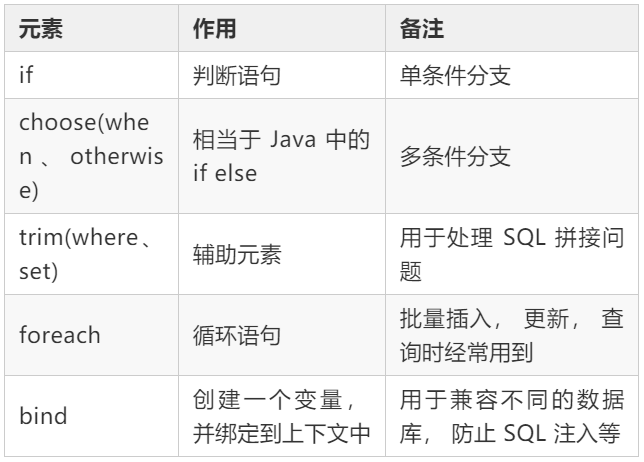MyBatis 动态 SQL(认真看看, 以后写SQL就爽多了)
共 13297字,需浏览 27分钟
·
2020-10-28 15:37
阅读本文大概需要 12 分钟。
MyBatis 令人喜欢的一大特性就是动态 SQL。在使用 JDBC 的过程中, 根据条件进行 SQL 的拼接是很麻烦且很容易出错的。
MyBatis 动态 SQL 的出现, 解决了这个麻烦。MyBatis通过 OGNL 来进行动态 SQL 的使用的。
目前, 动态 SQL 支持以下几种标签:

1 数据准备
DROP TABLE IF EXISTS `student`;CREATE TABLE `student` (
`student_id` int(10) unsigned NOT NULL AUTO_INCREMENT COMMENT '编号',
`name` varchar(20) DEFAULT NULL COMMENT '姓名',`phone` varchar(20) DEFAULT NULL COMMENT '电话',
`email` varchar(50) DEFAULT NULL COMMENT '邮箱',
`sex` tinyint(4) DEFAULT NULL COMMENT '性别',
`locked` tinyint(4) DEFAULT NULL COMMENT '状态(0:正常,1:锁定)',
`gmt_created` datetime DEFAULT CURRENT_TIMESTAMP COMMENT '存入数据库的时间',
`gmt_modified` datetime DEFAULT CURRENT_TIMESTAMP ON UPDATE CURRENT_TIMESTAMP COMMENT '修改的时间',
`delete` int(11) DEFAULT NULL,
PRIMARY KEY (`student_id`)
) ENGINE=InnoDB AUTO_INCREMENT=7 DEFAULT CHARSET=utf8mb4 COLLATE=utf8mb4_0900_ai_ci COMMENT='学生表';

2 if 标签
2.1 在 WHERE 条件中使用 if 标签
2.1.1 查询条件
当只输入用户名时, 使用用户名进行模糊检索;
当只输入性别时, 使用性别进行完全匹配
当用户名和性别都存在时, 用这两个条件进行查询匹配查询
2.1.2 动态 SQL
/**
* 根据输入的学生信息进行条件检索
* 1. 当只输入用户名时, 使用用户名进行模糊检索;
* 2. 当只输入邮箱时, 使用性别进行完全匹配
* 3. 当用户名和性别都存在时, 用这两个条件进行查询匹配的用
* @param student
* @return
*/
ListselectByStudentSelective(Student student);
<select id="selectByStudentSelective" resultMap="BaseResultMap" parameterType="com.homejim.mybatis.entity.Student">
select
"Base_Column_List" />
from student
where 1=1
<if test="name != null and name !=''">
and name like concat('%', #{name}, '%')
if>
<if test="sex != null">
and sex=#{sex}
if>
select>
<if test="name != null and name !=''">
and name like concat('%', #{name}, '%')
if>
<if test="sex != null">
and sex=#{sex}
if>
2.1.3 测试
@Test
public void selectByStudent() {
SqlSession sqlSession = null;
sqlSession = sqlSessionFactory.openSession();
StudentMapper studentMapper = sqlSession.getMapper(StudentMapper.class);
Student search = new Student();
search.setName("明");
System.out.println("只有名字时的查询");
ListstudentsByName = studentMapper.selectByStudentSelective(search);
for (int i = 0; i < studentsByName.size(); i++) {
System.out.println(ToStringBuilder.reflectionToString(studentsByName.get(i), ToStringStyle.MULTI_LINE_STYLE));
}
search.setName(null);
search.setSex((byte) 1);
System.out.println("只有性别时的查询");
ListstudentsBySex = studentMapper.selectByStudentSelective(search);
for (int i = 0; i < studentsBySex.size(); i++) {
System.out.println(ToStringBuilder.reflectionToString(studentsBySex.get(i), ToStringStyle.MULTI_LINE_STYLE));
}
System.out.println("姓名和性别同时存在的查询");
search.setName("明");
ListstudentsByNameAndSex = studentMapper.selectByStudentSelective(search);
for (int i = 0; i < studentsByNameAndSex.size(); i++) {
System.out.println(ToStringBuilder.reflectionToString(studentsByNameAndSex.get(i), ToStringStyle.MULTI_LINE_STYLE));
}
sqlSession.commit();
sqlSession.close();
}

where 1=1 and name like concat('%', ?, '%')

where 1=1 and sex=?

where 1=1 and name like concat('%', ?, '%') and sex=?
2.2 在 UPDATE 更新列中使用 if 标签
2.2.1 更新条件
2.2.1 动态 SQL
/**
* 更新非空属性
*/
int updateByPrimaryKeySelective(Student record);
"updateByPrimaryKeySelective" parameterType="com.homejim.mybatis.entity.Student">
update student
<set>
<if test="name != null">
`name` = #{name,jdbcType=VARCHAR},
if>
<if test="phone != null">
phone = #{phone,jdbcType=VARCHAR},
if>
<if test="email != null">
email = #{email,jdbcType=VARCHAR},
if>
<if test="sex != null">
sex = #{sex,jdbcType=TINYINT},
if>
<if test="locked != null">
locked = #{locked,jdbcType=TINYINT},
if>
<if test="gmtCreated != null">
gmt_created = #{gmtCreated,jdbcType=TIMESTAMP},
if>
<if test="gmtModified != null">
gmt_modified = #{gmtModified,jdbcType=TIMESTAMP},
if>
set>
where student_id = #{studentId,jdbcType=INTEGER}
2.2.3 测试
@Test
public void updateByStudentSelective() {
SqlSession sqlSession = null;
sqlSession = sqlSessionFactory.openSession();
StudentMapper studentMapper = sqlSession.getMapper(StudentMapper.class);
Student student = new Student();
student.setStudentId(1);
student.setName("明明");
student.setPhone("13838438888");
System.out.println(studentMapper.updateByPrimaryKeySelective(student));
sqlSession.commit();
sqlSession.close();
}

2.3 在 INSERT 动态插入中使用 if 标签
2.3.1 插入条件
2.3.2 动态SQL
/**
* 非空字段才进行插入
*/
int insertSelective(Student record);
"insertSelective" parameterType="com.homejim.mybatis.entity.Student">
insert into student
"(" suffix=")" suffixOverrides=",">
<if test="studentId != null">
student_id,
if>
<if test="name != null">
`name`,
if>
<if test="phone != null">
phone,
if>
<if test="email != null">
email,
if>
<if test="sex != null">
sex,
if>
<if test="locked != null">
locked,
if>
<if test="gmtCreated != null">
gmt_created,
if>
<if test="gmtModified != null">
gmt_modified,
if>
"values (" suffix=")" suffixOverrides=",">
<if test="studentId != null">
#{studentId,jdbcType=INTEGER},
if>
<if test="name != null">
#{name,jdbcType=VARCHAR},
if>
<if test="phone != null">
#{phone,jdbcType=VARCHAR},
if>
<if test="email != null">
#{email,jdbcType=VARCHAR},
if>
<if test="sex != null">
#{sex,jdbcType=TINYINT},
if>
<if test="locked != null">
#{locked,jdbcType=TINYINT},
if>
<if test="gmtCreated != null">
#{gmtCreated,jdbcType=TIMESTAMP},
if>
<if test="gmtModified != null">
#{gmtModified,jdbcType=TIMESTAMP},
if>
2.3.3 测试
@Test
public void insertByStudentSelective() {
SqlSession sqlSession = null;
sqlSession = sqlSessionFactory.openSession();
StudentMapper studentMapper = sqlSession.getMapper(StudentMapper.class);
Student student = new Student();
student.setName("小飞机");
student.setPhone("13838438899");
student.setEmail("xiaofeiji@qq.com");
student.setLocked((byte) 0);System.out.println(studentMapper.insertSelective(student));
sqlSession.commit();
sqlSession.close();
}

3 choose 标签
3.1 查询条件
当 studen_id 有值时, 使用 studen_id 进行查询;
当 studen_id 没有值时, 使用 name 进行查询;
否则返回空
3.2 动态SQL
/**
* - 当 studen_id 有值时, 使用 studen_id 进行查询;
* - 当 studen_id 没有值时, 使用 name 进行查询;
* - 否则返回空
*/
Student selectByIdOrName(Student record);
<select id="selectByIdOrName" resultMap="BaseResultMap" parameterType="com.homejim.mybatis.entity.Student">
select
"Base_Column_List" />
from student
where 1=1
<when test="studentId != null">
and student_id=#{studentId}
when>
<when test="name != null and name != ''">
and name=#{name}
when>
and 1=2
select>
3.3 测试
@Test
public void selectByIdOrName() {
SqlSession sqlSession = null;
sqlSession = sqlSessionFactory.openSession();
StudentMapper studentMapper = sqlSession.getMapper(StudentMapper.class);
Student student = new Student();
student.setName("小飞机");
student.setStudentId(1);
Student studentById = studentMapper.selectByIdOrName(student);
System.out.println("有 ID 则根据 ID 获取");
System.out.println(ToStringBuilder.reflectionToString(studentById, ToStringStyle.MULTI_LINE_STYLE));
student.setStudentId(null);
Student studentByName = studentMapper.selectByIdOrName(student);
System.out.println("没有 ID 则根据 name 获取");
System.out.println(ToStringBuilder.reflectionToString(studentByName, ToStringStyle.MULTI_LINE_STYLE));
student.setName(null);
Student studentNull = studentMapper.selectByIdOrName(student);
System.out.println("没有 ID 和 name, 返回 null");
Assert.assertNull(studentNull);
sqlSession.commit();
sqlSession.close();
}



4.1.1 查询条件
当只输入用户名时, 使用用户名进行模糊检索;
当只输入性别时, 使用性别进行完全匹配
当用户名和性别都存在时, 用这两个条件进行查询匹配查询
4.1.2 动态 SQL
当条件都不满足时:此时 SQL 中应该要不能有 where , 否则导致出错
当 if 有条件满足时:SQL 中需要有 where, 且第一个成立的 if 标签下的 and | or 等要去掉
/**
* 根据输入的学生信息进行条件检索
* 1. 当只输入用户名时, 使用用户名进行模糊检索;
* 2. 当只输入邮箱时, 使用性别进行完全匹配
* 3. 当用户名和性别都存在时, 用这两个条件进行查询匹配的用
*/
ListselectByStudentSelectiveWhereTag(Student student);
<select id="selectByStudentSelectiveWhereTag" resultMap="BaseResultMap" parameterType="com.homejim.mybatis.entity.Student">
select
"Base_Column_List" />
from student
<where>
<if test="name != null and name !=''">
and name like concat('%', #{name}, '%')
if>
<if test="sex != null">
and sex=#{sex}
if>
where>
select>
4.1.3 测试
@Test
public void selectByStudentWhereTag() {
SqlSession sqlSession = null;
sqlSession = sqlSessionFactory.openSession();
StudentMapper studentMapper = sqlSession.getMapper(StudentMapper.class);
Student search = new Student();
search.setName("明");
System.out.println("只有名字时的查询");
ListstudentsByName = studentMapper.selectByStudentSelectiveWhereTag(search);
for (int i = 0; i < studentsByName.size(); i++) {
System.out.println(ToStringBuilder.reflectionToString(studentsByName.get(i), ToStringStyle.MULTI_LINE_STYLE));
}
search.setSex((byte) 1);
System.out.println("姓名和性别同时存在的查询");
ListstudentsBySex = studentMapper.selectByStudentSelectiveWhereTag(search);
for (int i = 0; i < studentsBySex.size(); i++) {
System.out.println(ToStringBuilder.reflectionToString(studentsBySex.get(i), ToStringStyle.MULTI_LINE_STYLE));
}
System.out.println("姓名和性别都不存在时查询");
search.setName(null);
search.setSex(null);
ListstudentsByNameAndSex = studentMapper.selectByStudentSelectiveWhereTag(search);
for (int i = 0; i < studentsByNameAndSex.size(); i++) {
System.out.println(ToStringBuilder.reflectionToString(studentsByNameAndSex.get(i), ToStringStyle.MULTI_LINE_STYLE));
}
sqlSession.commit();
sqlSession.close();
}



4.2 set
updateByPrimaryKeySelective没有使用4.3 trim
4.3.1 trim 来表示 where
<trim prefix="where" prefixOverrides="AND |OR">
trim>
4.3.2 trim 来表示 set
<trim prefix="SET" suffixOverrides=",">
trim>
4.3.3 trim 的几个属性
prefix: 当 trim 元素包含有内容时, 增加 prefix 所指定的前缀
prefixOverrides: 当 trim 元素包含有内容时, 去除 prefixOverrides 指定的 前缀
suffix: 当 trim 元素包含有内容时, 增加 suffix 所指定的后缀
suffixOverrides:当 trim 元素包含有内容时, 去除 suffixOverrides 指定的后缀
5 foreach 标签
collection: 必填, 集合/数组/Map的名称.
item: 变量名。即从迭代的对象中取出的每一个值
index: 索引的属性名。当迭代的对象为 Map 时, 该值为 Map 中的 Key.
open: 循环开头的字符串
close: 循环结束的字符串
separator: 每次循环的分隔符
5.1 在 where 中使用 foreach
5.1.1 查询条件
5.1.2 动态 SQL
/**
* 获取 id 集合中的用户信息
* @param ids
* @return
*/
ListselectByStudentIdList(List ids);
<select id="selectByStudentIdList" resultMap="BaseResultMap">
select
"Base_Column_List" />
from student
where student_id in
<foreach collection="list" item="id" open="(" close=")" separator="," index="i">
#{id}
foreach>
select>
5.1.3 测试
@Test
public void selectByStudentIdList() {
SqlSession sqlSession = null;
sqlSession = sqlSessionFactory.openSession();
StudentMapper studentMapper = sqlSession.getMapper(StudentMapper.class);
Listids = new LinkedList<>();
ids.add(1);
ids.add(3);
Liststudents = studentMapper.selectByStudentIdList(ids);
for (int i = 0; i < students.size(); i++) {
System.out.println(ToStringBuilder.reflectionToString(students.get(i), ToStringStyle.MULTI_LINE_STYLE));
}
sqlSession.commit();
sqlSession.close();
}

5.2 foreach 实现批量插入
5.2.1 动态SQL
/**
* 批量插入学生
*/
int insertList(Liststudents) ;
"insertList">
insert into student(name, phone, email, sex, locked)
values
<foreach collection="list" item="student" separator=",">
(
#{student.name}, #{student.phone},#{student.email},
#{student.sex},#{student.locked}
)
foreach>
5.2.2 测试
@Test
public void insertList() {
SqlSession sqlSession = null;
sqlSession = sqlSessionFactory.openSession();
StudentMapper studentMapper = sqlSession.getMapper(StudentMapper.class);
Liststudents = new LinkedList<>();
Student stu1 = new Student();
stu1.setName("批量01");
stu1.setPhone("13888888881");
stu1.setLocked((byte) 0);
stu1.setEmail("13888888881@138.com");
stu1.setSex((byte) 1);
students.add(stu1);
Student stu2 = new Student();
stu2.setName("批量02");
stu2.setPhone("13888888882");
stu2.setLocked((byte) 0);
stu2.setEmail("13888888882@138.com");
stu2.setSex((byte) 0);
students.add(stu2);
System.out.println(studentMapper.insertList(students));
sqlSession.commit();
sqlSession.close();
}

6 bind 标签
selectByStudentSelective方法中, 有如下<if test="name != null and name !=''">
and name like concat('%', #{name}, '%')
if>
<if test="name != null and name !=''">
<bind name="nameLike" value="'%'+name+'%'"/>
and name like #{nameLike}
if>

推荐阅读:
面试官写了个双冒号::问我这是什么语法?Java中有这玩意?
微信扫描二维码,关注我的公众号
朕已阅 

